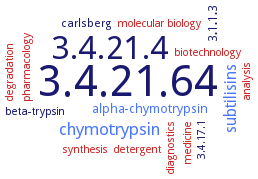3.4.21.64: peptidase K
This is an abbreviated version!
For detailed information about peptidase K, go to the full flat file.

Word Map on EC 3.4.21.64 
-
3.4.21.64
-
3.4.21.4
-
chymotrypsin
-
subtilisins
-
alpha-chymotrypsin
-
carlsberg
-
3.1.1.3
-
synthesis
-
degradation
-
beta-trypsin
-
diagnostics
-
analysis
-
pharmacology
-
molecular biology
-
medicine
-
detergent
-
3.4.17.1
-
biotechnology
- 3.4.21.64
-
3.4.21.4
- chymotrypsin
- subtilisins
- alpha-chymotrypsin
-
carlsberg
-
3.1.1.3
- synthesis
- degradation
- beta-trypsin
- diagnostics
- analysis
- pharmacology
- molecular biology
- medicine
- detergent
-
3.4.17.1
- biotechnology
Reaction
Hydrolysis of keratin, and of other proteins with subtilisin-like specificity. Hydrolyses peptide amides =
Synonyms
EC 3.4.21.14, EC 3.4.21.4, EC 3.4.4.16, endopeptidase K, mesophilic proteinase K, PROK, Proteinase K, Proteinase, Tritirachium album serine, Tritirachium album proteinase K, Tritirachium alkaline proteinase
ECTree
Advanced search results
Metals Ions
Metals Ions on EC 3.4.21.64 - peptidase K
Please wait a moment until all data is loaded. This message will disappear when all data is loaded.
Ca2+
Calcium
Cu2+
proteinase K and Cu2+ ions are used to synthesize enzyme-inorganic hybrid nanoflowers (P-hNFs). The P-hNFs exhibit better activity than free proteinase K in the presence of all surfactants, i.e. CHAPS, DOC, SDS, Triton X-100 and Tergitol, except for Tween 80. synthesized enzyme-inorganic hybrid nanoflowers (P-hNFs) can potentially be used as an additive in detergent formulations
dysprosium
1 mM DyCl3, differential scanning calorimetry analysis bound to the enzyme
europium
1 mM EuCl33, differential scanning calorimetry analysis bound to the enzyme
gadolinium
1 mM GdCl33, differential scanning calorimetry analysis bound to the enzyme
holmium
1 mM HoCl3, differential scanning calorimetry analysis bound to the enzyme
lanthanum
1 mM La(NO3)3, differential scanning calorimetry analysis bound to the enzyme
lutetium
1 mM LuCl3, differential scanning calorimetry analysis bound to the enzyme
neodymium
1 mM NdCl3, differential scanning calorimetry analysis bound to the enzyme
Pr3+
1 mM PrCl3, the denaturation temperature of proteinase K derivatized with praseodymium (Pr) ions is 16.2°C, which is 5.9°C higher than those of metal-free and Ca2+-bound proteinase K, respectively. Isothermal titration calorimetry (ITC) measurements demonstrate that Pr-ion binding to proteinase K shows endothermic peaks, whereas Ca2+-ion binding shows exothermic peaks, indicating that the binding mode of Pr ions is different from that of Ca2+ ions, even though the crystal structures of proteinase K with Pr and Ca2+ ions are identical. Hydrolytic activity of Pr-derivatized proteinase K shows that the hydrolytic activity is 46fold higher at 70°C using synthetic nitroanilide substrate and 9 and 76fold higher at 70°C and 80°C using fluorescein isothiocyanate-labeled casein, respectively, in comparison with the native proteinase K. Furthermore, based on the yield of chemoenzymatic peptide syntheses, the aminolysis activity of Pr-derivatized proteinase K is 3.5 and 9.5fold higher than that of the native proteinase K at 50°C and 60°C, respectively. Analysis of the mechanism by which Pr ions enhance the thermal stability of proteinase K, overview
samarium
1 mM SmCl3, differential scanning calorimetry analysis bound to the enzyme
SDS
-
stimulates hydrolysis of serum albumin in a dose-dependent manner, caused primarily by denaturation of the protein substrate, inactivates with an oligopeptide as substrate
Urea
-
stimulates hydrolysis of serum albumin in a dose-dependent manner, caused primarily by denaturation of the protein substrate
ytterbium
1 mM YbCl3, differential scanning calorimetry analysis bound to the enzyme
additional information
differential scanning calorimetry curves for proteinase K derivatized with heavy atoms, showing the correlation between atomic number and denaturation temperature, overview
Ca2+
1 mM CaCl2, the denaturation temperature of proteinase K derivatized with praseodymium (Pr) ions is 16.2°C, which is 5.9°C higher than those of metal-free and Ca2+-bound proteinase K, respectively. Isothermal titration calorimetry (ITC) measurements demonstrate that Pr-ion binding to proteinase K shows endothermic peaks, whereas Ca2+-ion binding shows exothermic peaks, indicating that the binding mode of Pr ions is different from that of Ca2+ ions, even though the crystal structures of proteinase K with Pr and Ca2+ ions are identical
Calcium
-
the second more mobile Ca2+ site bridges 2 loops close to the amino and the carboxy termini
Calcium
-
X-ray studies show that it has 2 binding sites for Ca2+, Ca2+ is not directly involved in the catalytic mechanism and is 16.6 A away from the alpha-carbon atoms of the catalytic triad Asp39-His69-Ser224, the activity of the enzyme towards the synthetic substrate succinyl-Ala-Ala-Ala 4-nitroanilide drops slowly to about 20% of its original value when it is depleted of Ca2+
Calcium
-
2 calcium ions are bound to the native enzyme, activity drops by 70% if this Ca2+ is removed by EDTA
Calcium
-
the first calcium site is formed by the loop of the residues 174-178 and Asp200


 results (
results ( results (
results ( top
top






